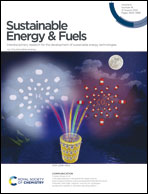S-scheme heterojunction AgCl/g-C3N4 with a unique electron transfer channel via a built-in electric field for enhanced H2 production†
Abstract
The polyunsaturated edge Ag in a surface-modified catalyst plays a prominent role in the accumulation of electrons during photocatalytic H2 production. Nevertheless, a moderate and straightforward method for efficiently baring edge Ag is still a grand challenge. Herein, cubic phase AgCl is prepared as an effective cocatalyst to modify the surface of g-C3N4, which restricts the agglomeration between g-C3N4 layers and results in efficient and sustainable photocatalytic H2 production. The supreme AgCl/g-C3N4 catalyst realizes a H2 evolution of 120.39 μmol in 4 h and good sustainability. The lifetime of photoexcited electrons in g-C3N4 is effectively prolonged within the S-scheme heterojunction. In addition, AgCl supplies extensive polyunsaturated edges of Ag as active sites. Meanwhile, the N2 TPD data shows that chemisorption of H2O abates dissociation energy for H2O splitting, hence promoting H2 production performance. This study emphasizes the importance of a built-in electric field and a unique electron transfer channel for improving electron utilization of AgCl/g-C3N4 to strengthen the H2 evolution activity.

- This article is part of the themed collection: Sustainable Energy & Fuels Recent HOT Articles


 Please wait while we load your content...
Please wait while we load your content...